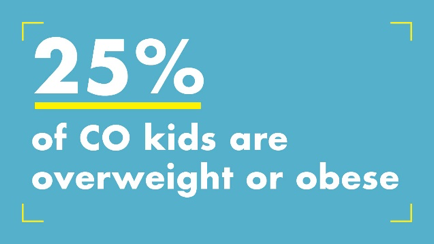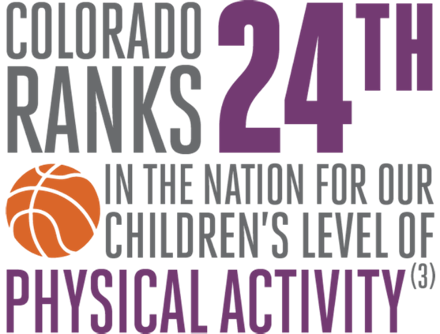By Sarah Kurz, LiveWell Colorado Vice President of Policy and Communications
While Coloradans have much to be proud of, the reality is that we’re not as healthy as we think we are, especially our kids. Colorado’s great quality of life has attracted healthy, educated adults yet we’ve struggled to provide that same healthy environment for the children born and raised here. One in four Colorado kids is overweight or obese.[i]
 Healthy youth are fundamental to Colorado’s future. That’s why we partner with A+ Colorado and other organizations to advocate for increased and improved physical education in Colorado schools. Our education system can and should play a critical role in ensuring our kids grow up healthy.
Healthy youth are fundamental to Colorado’s future. That’s why we partner with A+ Colorado and other organizations to advocate for increased and improved physical education in Colorado schools. Our education system can and should play a critical role in ensuring our kids grow up healthy.
Yet Colorado ranks a mediocre 24th in the nation for our children’s level of physical activity[ii] with nearly 55 percent of kids not getting the recommended amount of physical activity each week.[iii]Colorado is one of only three states where physical education is not a required part of our state’s public school curriculum at the elementary, middle or secondary level.[iv] Additionally, less than half of all Colorado middle school students attend PE five days a week, and nearly a third of Colorado middle schoolers don’t play sports outside of school. Physical activity is not just good for kids’ bodies, but also for their brains.
Physical activity during the school day (e.g., recess, PE, classroom movement breaks) has been linked to immediate gains in cognitive performance, improved academic performance, standardized test performance, grades and higher levels of brain activity.[v] Kids who are physically active during the school day also have fewer behavior problems[vi]. Disciplinary action and suspensions among students also decreased when PE is offered for 5 days per week[vii]. By helping kids be more physically active and eat well, we can help them succeed academically, better preparing them for lifelong success.
 Physical activity in schools is critical because in many cases Colorado children lack parks and playgrounds in their neighborhoods, so they can’t get the physical activity they need to be healthy.[viii] Approximately 30 percent of Colorado kids live in neighborhoods without parks, community centers and/or safe sidewalks, limiting their ability to be physically active.[ix] Chronic diseases, including diabetes and heart disease, are more prevalent among poor or less educated individuals than those with higher incomes or more education,[x] and that is due in large part to unequal opportunities to have healthy lifestyles.
Physical activity in schools is critical because in many cases Colorado children lack parks and playgrounds in their neighborhoods, so they can’t get the physical activity they need to be healthy.[viii] Approximately 30 percent of Colorado kids live in neighborhoods without parks, community centers and/or safe sidewalks, limiting their ability to be physically active.[ix] Chronic diseases, including diabetes and heart disease, are more prevalent among poor or less educated individuals than those with higher incomes or more education,[x] and that is due in large part to unequal opportunities to have healthy lifestyles.
The conditions at work, home, and school have a big impact on our health, and many people face barriers that prevent them from making healthy choices, or from even having a choice at all. Latinos, African Americans and low-income families often are more likely to lack healthy food options and safe places to be physically active close to home.[xi] These barriers to healthy food and physical activity can lead to higher rates of obesity. Twenty-five percent of Coloradans who make $25,000 or less are obese compared to 20 percent of those making $50,000 or more.[xii] Our public schools offer an opportunity to level the playing field for these kids and their families by ensuring that all students have access to a high-quality education that includes regular physical education.
Our goal at LiveWell Colorado is to remove barriers to healthy living. That’s why LiveWell Colorado works across the state to serve the communities, schools, cities and towns with the greatest needs when it comes to health access and equity. You can send a message to schools and districts that you value physical activity as part of a well-balanced education.
We hope you will join us in this effort by signing up here to help. Are you in?
[i] Colorado Department of Public Health and Environment. “Colorado Child Health Survey 2014 Snapshot Report.” http://www.chd.dphe.state.co.us/topics.aspx?q=Maternal_Child_Health_Data
[ii] The Colorado Health Foundation. “The 2015 Colorado Health Report Card.” 2015. http://www.ColoradoHealth.org/ReportCard
[iii] Colorado Department of Public Health and Environment. “Colorado’s Child Health Survey.” 2014 Snapshot. http://www.chd.dphe.state.co.us/Resources/mchdata/CHS/Colorado%20Child%20Health%20Survey%202014%20Snapshot.pdf
[iv] Shape of the Nation 2016 http://www.shapeamerica.org/advocacy/son/2016/upload/Shape-of-the-Nation-2016_web.pdf
[v] Hillman et al. 2009. The effect of acute treadmill walking on cognitive control and academic achievement in preadolescent children. http://www.ncbi.nlm.nih.gov/pubmed/19356688; Centers for Disease Control and Prevention. The association between school based physical activity, including physical education, and academic performance. Atlanta, GA: U.S. Department of Health and Human Services; 2010. http://www.cdc.gov/healthyschools/health_and_academics/pdf/pa-pe_paper.pdf
[vi] http://www.peforallcolorado.org/pe-success-stories/
[vii] Ibid.
[viii] Centers for Disease Control and Prevention. “Colorado Action Guide for the State Indicator Report on Physical Activity, 2014”
[ix] Ibid.
[x] Income, Education and Obesity: A Closer Look at Inequities in Colorado’s Obesity Problem.” The Colorado Health Foundation, 2008. http://www.coloradohealth.org/studies.aspx
[xii] 2014 BRFSS data “Overweight and Obesity in Colorado: Data Infographic. Colorado Adults, Teens, and Children” http://www.chd.dphe.state.co.us/Weight/obesity-in-Colorado-infographic.html